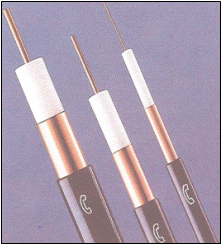Exercise 4.4: Coaxial Cable - Frequency Response
A so-called normal coaxial cable of length $l$ with
- core diameter $\text{2.6 mm}$, and
- outer diameter $\text{9.5 mm}$
has the following frequency response:
- $$H_{\rm K}(f) = {\rm e}^{- \alpha_0 \hspace{0.05cm} \cdot \hspace{0.05cm} l} \cdot {\rm e}^{- \alpha_1 \hspace{0.05cm}\cdot \hspace{0.05cm}l \hspace{0.05cm}\cdot \hspace{0.05cm}f} \cdot {\rm e}^{- \alpha_2 \hspace{0.05cm}\cdot \hspace{0.05cm}l\hspace{0.05cm}\hspace{0.05cm}\cdot \sqrt{f}} \cdot {\rm e}^{- {\rm j} \hspace{0.05cm}\cdot \hspace{0.05cm} \beta_1 \hspace{0.05cm}\cdot \hspace{0.05cm} l \hspace{0.05cm}\cdot \hspace{0.05cm}f} \cdot {\rm e}^{- {\rm j} \hspace{0.05cm}\cdot \hspace{0.05cm} \beta_2 \hspace{0.05cm}\cdot \hspace{0.05cm}l\hspace{0.05cm}\hspace{0.05cm}\cdot \sqrt{f}} \hspace{0.05cm}.$$
The attenuation parameters $\alpha_0$, $\alpha_1$ and $\alpha_2$ are to be used in "Neper per kilometer" (Np/km) and the phase parameters $\beta_1$ and $\beta_2$ in "Radian per kilometer" (rad/km). The following numerical values apply:
- $$\alpha_0 = 0.00162 \hspace{0.15cm}{\rm Np}/{\rm km} \hspace{0.05cm},$$
- $$\alpha_1 = 0.000435 \hspace{0.15cm} {\rm Np}/{{\rm km} \cdot {\rm MHz}} \hspace{0.05cm},$$
- $$\alpha_2 = 0.2722 \hspace{0.15cm}{\rm Np}/{{\rm km} \cdot \sqrt{\rm MHz}} \hspace{0.05cm}.$$
For the system-theoretical description of a coaxial cable (German: "Koaxialkabel" ⇒ subscipt "K"), one uses
- the attenuation function (in Np or dB):
- $${ a}_{\rm K}(f) = - {\rm ln} \hspace{0.10cm}|H_{\rm K}(f)|= - 20 \cdot {\rm lg} \hspace{0.10cm}|H_{\rm K}(f)| \hspace{0.05cm},$$
- the phase function (in rad or degree):
- $$b_{\rm K}(f) = - {\rm arc} \hspace{0.10cm}H_{\rm K}(f) \hspace{0.05cm}.$$
In practice, one often uses the approximation
- $$H_{\rm K}(f) = {\rm e}^{- \alpha_2 \hspace{0.05cm}\cdot \hspace{0.05cm}l\hspace{0.05cm}\hspace{0.05cm}\cdot \sqrt{f}} \cdot {\rm e}^{- {\rm j} \hspace{0.05cm}\cdot \hspace{0.05cm} \beta_2 \hspace{0.05cm}\cdot \hspace{0.05cm}l\hspace{0.05cm}\hspace{0.05cm}\cdot \sqrt{f}}$$
- $$\Rightarrow \hspace{0.3cm} a_{\rm K}(f) = \alpha_2 \cdot l \cdot \sqrt{f}, \hspace{0.8cm}b_{\rm K}(f) = a_{\rm K}(f) \cdot {\rm rad}/{\rm Np}\hspace{0.05cm}.$$
This is allowed because $\alpha_2$ and $\beta_2$ have exactly the same numerical value and differ only by different pseudo units.
With the definition of the characteristic cable attenuation (in Neper or decibel)
- $${a}_{\rm \star(Np)} = {a}_{\rm K}(f = {R}/{2}) = 0.1151 \cdot {a}_{\rm \star(dB)}$$
digital systems with different bit rate $R$ and cable length $l$ can be treated uniformly.
Notes:
- The exercise belongs to the chapter Properties of Coaxial Cables.
- You can use the interactive "HTML 5/JS" applet Attenuation of Copper Cables to check your results.
Questions
Solution
- The $\alpha_0$–term causes only a frequency-independent attenuation.
- The $\beta_1$–term (linear phase) results in a frequency-independent delay.
- All other terms contribute to the (linear) distortions.
(2) With ${\rm a}_0 = \alpha_0 \cdot l$ the following equation must be satisfied:
- $${\rm e}^{- {\rm a}_0 } \ge 0.99 \hspace{0.3cm} \Rightarrow \hspace{0.3cm}{\rm a}_0 < {\rm ln} \hspace{0.10cm}\frac{1}{0.99}\approx 0.01\,\,{\rm (Np)} \hspace{0.05cm}.$$
- This gives the maximum cable length:
- $$l_{\rm max} = \frac{{\rm a}_0 }{\alpha_0 } = \frac{0.01\,\,{\rm Np}}{0.00162\,\,{\rm Np/km}}\hspace{0.15cm}\underline{\approx 6.173\,\,{\rm km}} \hspace{0.05cm}.$$
(3) The following applies to the attenuation curve when all terms are taken into account:
- $${a}_{\rm K}(f) = [\alpha_0 + \alpha_1 \cdot f + \alpha_2 \cdot \sqrt{f}\hspace{0.05cm}] \cdot l = \big[0.00162 + 0.000435 \cdot 70 + 0.2722 \cdot \sqrt{70}\hspace{0.05cm}\big]\, \frac{\rm Np}{\rm km} \cdot 2\,{\rm km} $$
- $$ \Rightarrow \hspace{0.3cm}{a}_{\rm K}(f = 70\ \rm MHz) = \big[0.003 + 0.061 + 4.555 \hspace{0.05cm}\big]\, {\rm Np}\hspace{0.15cm}\underline{= 4.619\, {\rm Np}}\hspace{0.05cm}.$$
(4) According to the calculation in subtask (3), the attenuation value ${a}_{\rm K}(f = 70\ \rm MHz)\hspace{0.15cm}\underline{=4.555 \ \rm Np}$ is obtained here.
(5) For any positive quantity $x$ the following holds:
- $$x_{\rm Np} = {\rm ln} \hspace{0.10cm} x = \frac{{\rm lg} \hspace{0.10cm} x}{{\rm lg} \hspace{0.10cm} {\rm e}} = \frac{1}{{20 \cdot \rm lg} \hspace{0.10cm} {\rm e}} \cdot (20 \cdot {\rm lg} \hspace{0.10cm} x) = 0.1151 \cdot x_{\rm dB} \hspace{0.3cm} \Rightarrow \hspace{0.3cm} x_{\rm dB} = 8.6859 \cdot x_{\rm Np}\hspace{0.05cm}.$$
The attenuation value $4.555 \ {\rm Np}$ is thus identical to ${a}_{\rm K}(f = 70\ \rm MHz)\hspace{0.15cm}\underline{=39.56 \ \rm dB}$.
(6) Solutions 1, 4 and 5 are correct. Explanation:
- With the restriction to the attenuation term with $\alpha_2$, the following applies to the frequency response:
- $$H_{\rm K}(f) = {\rm e}^{- \alpha_2 \hspace{0.05cm}\cdot \hspace{0.05cm}l\hspace{0.05cm}\hspace{0.05cm}\cdot \sqrt{f}} \cdot {\rm e}^{- {\rm j} \hspace{0.05cm}\cdot \hspace{0.05cm} \beta_1 \hspace{0.05cm}\cdot \hspace{0.05cm} l \hspace{0.05cm}\cdot f} \cdot {\rm e}^{- {\rm j} \hspace{0.05cm}\cdot \hspace{0.05cm} \beta_2 \hspace{0.05cm}\cdot \hspace{0.05cm}l\hspace{0.05cm}\hspace{0.05cm}\cdot \sqrt{f}} \hspace{0.05cm}.$$
- If the $\beta_1$–phase term is omitted, nothing changes with respect to the distortions. Only the phase and group delay would be (both equal) smaller by the value $\tau_1 = (\beta_1 \cdot l)/(2\pi)$.
- If, on the other hand, we omit the $\beta_2$–term, we obtain completely different conditions:
- (a) The frequency response $H_{\rm K}(f)$ no longer fulfills the requirement of a causal system; in such a case, $H_{\rm K}(f)$ would have to be in minimum phase.
- (b) The impulse response $h_{\rm K}(t)$ is symmetrical at $t = 0$ with real frequency response, which does not correspond to the conditions.
- Therefore, as an approximation for the coaxial cable frequency response, the following is allowed:
- $${a}_{\rm K}(f) = \alpha_2 \cdot l \cdot \sqrt{f},$$
- $$ b_{\rm K}(f) = a_{\rm K}(f) \cdot {\rm rad}/{\rm Np}\hspace{0.05cm}.$$
- That means: ${a}_{\rm K}(f)$ and ${b}_{\rm K}(f)$ of a coaxial cable are in first approximation identical in shape and differ only in their units.
- For a digital system with bit rate $R = 140 \ \rm Mbit/s$ ⇒ $R/2 = 70 \ \rm Mbit/s$ and cable length $l = 2 \ \rm km$ , $a_\star \approx 40 \ \rm dB$ holds (see solution to the last sub-task).
- A system with four times the bit rate $R/2 = 280 \ \rm Mbit/s$ and half the length $(l = 1 \ \rm km)$ results in the same characteristic cable attenuation.
- In contrast, the following holds for a system with $R/2 = 35 \ \rm Mbit/s$ and $l = 2 \ \rm km$:
- $${a}_\star = 0.2722 \hspace{0.15cm}\frac {\rm Np}{\rm km \cdot \sqrt{MHz}} \cdot {\rm 2\,km}\cdot\sqrt{\rm 35\,MHz} \cdot 8.6859 \,\frac {\rm dB}{\rm Np} \approx 28\,{\rm dB} \hspace{0.05cm}.$$
